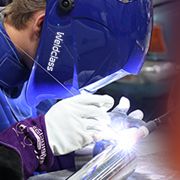How to weld Cast Iron | Cast Iron crack repair
Welding of cast iron has unique challenges, especially prevention of further cracking. Here's a simple guide to help you get it right.
1. What Welding Processes / Methods Can Be Used for Cast Iron?
Stick/MMA:
Stick is arguably the best and most popular process when it comes to crack repair of common cast irons, especially where users have limited equipment and/or experience. Cast iron rods/electrodes are readily available in small qtys (or 'handy packs') which is ideal for one-off jobs.
Oxy Brazing:
Not as strong as welding, and may not be suitable for applications where the casting will be subject to high service temperatures (for example manifolds and engine parts). However can be a good option where the component will not be subject to load/tension or high tempeartures and/or repair of difficult-to-weld types of cast iron where welding processes are not successful.
Weldclass Brazing Rods
Oxy Welding:
In times past this was a popular method, before electric/arc welders became more affordable and widely used. Sourcing the correct type of filler rod can be difficult, due to the declining popularity of this process. Note this is only possible with Oxy-Acetylene (not Oxy-LPG).
MIG:
Typically a user-friendly process, however cast iron MIG wire can be difficult and costly to source. Worth considering for larger or repetitive jobs.
TIG:
Requires more experience/skill vs Stick or MIG welding. Does not produce spatter, which is an advantage when repairing critical surfaces where spatter may cause damage or costly and time-consuming clean-up. Sourcing the correct type of filler rod can be difficult & costly.
The following welding guide is written for stick welding, however the general principles apply to all processes.
2. Cleaning
It is absolutely critical that the weld area is very clean. Dirt, oil and impurities will make it impossible to achieve a sound weld. Steam cleaning (or hot water) is often the best method, as impurities are often absorbed into the porous surface of cast iron. Clean around and on all sides of component, not just the direct surfaces to be welded.
3. Preparation
Vee out cracks using a rotary burr or grinding disc, often a U-shaped groove is best. Or if butt welding pieces together, bevel the edges of the joint.
4. Welding Electrode Selection:
Specialist cast-iron electrodes should be used, which have a high nickel content of between 50% and 99%. (Some welders will claim that it is possible to use 'general purpose' steel electrodes to weld cast iron. While this is possible in some applications, cracking is far more likely and this is definitely not recommended).
Weldclass Platinum NiFe 3.2mm Cast Iron electrodes are suitable for welding common cast irons to themselves and to steel. The weld metal is also stronger and more resistant to solidification cracking than the pure nickel (Ni-Cl) electrode types.
For critical applications, welding of specialist or sensitive equipment, etc you may need to consult a metallurgist and/or the original manufacturer of the equipment being welded, to determine the correct type of welding consumable.
Weldclass Cast Iron Electrodes
5. Heat-treat vs Cold Welding
Becuase cast iron is comparitively brittle and prone to cracking (compared to steel), the control of heat is critical to achieving a successful weld. Localised heat caused by welding causes the 'hot' metal to expand and contract at a different rate vs the 'cold' metal, which can cause further cracking to the casting itself, and/or cracking of the new weld metal as it solidifies, or cracking later when in service.
Preheating and postheating is strongly recommended. Cast iron welding often involves the repair of a unique, hard-to-replace part which means you want everything in your favour to achieve the best possible result the first time around.
'Cold welding' of cast iron is possible in some applications. However, this is riskier and more challenging than 'hot welding', and we do not recommend this unless you have a) prior experience welding the same component / application, or b) are able to run some test welds first.
6. Preheating
Pre-heat the casting / component to around 120-150oc before welding.
If you have limited access to heating equipment, small components can be heated in a conventional cooking oven, which also makes it easy to control temperature.
Larger components will require an oxy torch or LPG burner torch like the Platinum LT40. Unless you have equipment such as infrared thermometer, it can be tricky to measure (or estimate) the temperature. In any case, preheating is always better than no heating at all. It is important to heat the casting as evenly as possible.
7. Weld Technique
Following are recommended techniques for successful stick/MMA welding of cast iron. These steps are especially important if the casting is, or will be, subject to load stress or tension.
- Run short weld beads (around 25mm long) at a time, to avoid over-heating
- Excessive current will cause over-heating, keep current/amps setting as low as possible within the range recommended by the eletrode manufacturer
- Rather than running each bead beside the next, stagger the welds over the length of the crack to help evenly spread heat and tension. For example, place a bead at each end of the crack, then in the middle, then stagger the rest.
- Peining each weld for 1-2 minutes - using a ball pein hammer immediately after each weld bead - helps to reduce the stresses induced by the contraction of the metal as it gets cooler. While this is not always essential, it is recommended where the risk of cracking is high, including applications where the casting will be subject to loads/tension.
- If the end of the last weld is too full or lumpy, grind the end back a little so you have an ideal start that will not encourage slag inclusions
- Repeat above procedure until finished, ensuring that sufficient heat remains in the job (depending on the size of the weld, you may need to re-heat partway through the weld process)
8. Postheating
Postheating is as equally important as preheating in preventing cracking. Re-heat the casting to encourage an even general heat then wrap the job in some material (such as a welding blanket or heavy rags) that will help retain the heat and allow the component to cool as slowly as possible.


